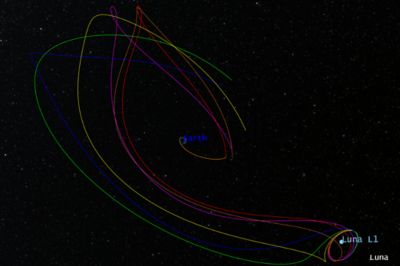ANSYS BLOG
March 8, 2023
Cislunar Mission Design with Ansys STK
The satellite industry is buzzing about one term: cislunar. If you haven’t heard it regularly yet, you probably will soon — but what’s so special about this orbit regime nestled between Earth and the Moon? What challenges does this regime pose, and how can we solve them?
Cislunar Concerns
Missions in cislunar space represent a significant paradigm shift from the Earth-based missions we’ve been executing for years. No longer are our orbits beautifully stable Keplerian arcs; rather, they are more akin to balancing on a knife’s edge waiting for any small excitation to send us hurtling back to Earth or toward the Moon. The task of designing and maintaining three-body trajectories, like those required for most cislunar orbits of interest, is more than a step up from designing two-body orbits — it’s a whole different world. Beyond just designing trajectories, of course, these satellite missions have a job to do, and we must answer additional complex questions:
- Will my communications payload function effectively?
- Can I image with the required fidelity?
- How does my thermal profile change in cislunar space?
- Can I effectively track my satellite? How?
- Can I determine and control my satellite’s attitude?
None of these questions are easy to solve, and most require that we reconsider the convenient assumptions of Earth-based missions we have become so accustomed to. Not only is preliminary design a challenge in cislunar space, but cranking up the fidelity to an operational level is eventually crucial for all programs. Our tools have been used on multiple high-profile lunar and cislunar missions in recent years, and we're here to help.

Sample Earth-Moon L1 halo orbit family.
Defining Trajectories
The first part of any cislunar mission is the trajectory design. Oftentimes these missions call for unique orbit characteristics that can only exist around Lagrange points in a three-body system (Halo, Lyupanov, etc.). Using Ansys System Tool Kit’s (STK) Astrogator capability, you can model the circular-restricted three body problem (CR3BP), which is a foundational building block used to design three-body orbits under simplified conditions. Once an orbit has been converged within the CR3BP, users can converge a full-force model version of their orbit using STK’s industry-leading propagators and differential correctors. Additionally, to model the approach and insertion trajectories into a three-body orbit, you can use the state transition matrix (STM) to create manifolds leading into the orbit family.

Sample manifold generated in Ansys STK.
Advanced Analysis
But it doesn’t stop there — all of the detailed payload mission analysis you know and love in STK is still available within lunar and cislunar space.
Cislunar space is a convenient location to perform imaging and electro-optical infrared (EOIR) missions. As with Earth-based domains, STK’s EOIR capability enables you to simulate images in lunar and cislunar space.
In recent Ansys Orbit Determination Tool Kit (ODTK) releases, we added additional measurement types including multilegged doppler, bistatic ranging/doppler, and the ability to process GNSS-type measurements in Moon-centered systems. This video contains a detailed discussion on lunar and cislunar orbit determination.
Thermal profiles can vary significantly in lunar and cislunar space. To help with that, Ansys recently acquired Thermal Desktop. This acquisition enables tighter integration between the mission model in STK and the thermal loading analysis in Thermal Desktop. You can also leverage volumetrics to understand eclipse effects spatially.
Cislunar Resources
For a great conversation between AGI engineers and Space Exploration Engineering (SEE), watch this video:
Did you know that you can design a Moon mission from Earth in under five minutes with STK?
Check out an interesting demonstration about tracking and communications modeling with a lunar constellation in STK and ODTK in our upcoming webinar on March 21.
We are always here to help. Please don’t hesitate to contact us whenever you want help with cislunar or any other topic. To learn more about what Ansys STK and Ansys ODTK can do for your cislunar missions, visit our digital mission engineering page.